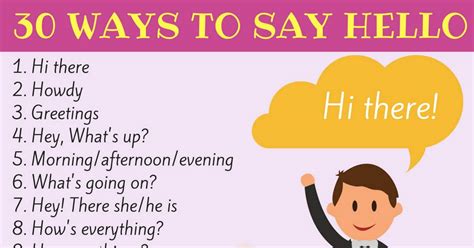How To Say Hi in English: A Comprehensive Guide
Saying "hi" seems simple, right? But mastering greetings in English goes beyond just knowing the basics. This guide dives deep into various ways to greet someone in English, depending on the context, your relationship with the person, and the time of day. We'll cover everything from formal to informal greetings, helping you navigate any social situation with confidence.
Basic Ways to Say Hi in English
The most common way to say "hi" in English is, well, "hi"! It's informal, friendly, and universally understood. Other equally simple and common alternatives include:
- Hello: Slightly more formal than "hi," but still perfectly acceptable in most situations.
- Hey: Even more informal than "hi," suitable for close friends and family.
- Howdy: A more regional greeting, often used in the southern United States.
Stepping Up Your Greeting Game: More Formal Options
While "hi" and "hello" work well in most casual settings, certain situations call for a more formal approach. Consider these options:
- Good morning/afternoon/evening: These greetings are time-specific and demonstrate politeness. "Good morning" is typically used until noon, "good afternoon" until evening, and "good evening" after sunset.
- It's a pleasure to meet you: This phrase is used when meeting someone for the first time, emphasizing politeness and professionalism.
- How do you do?: This is a very formal greeting, often used in extremely formal settings or when meeting someone of high social standing. The typical response is "How do you do?" – essentially acknowledging the greeting without offering detailed information.
Adding Personality to Your Greetings
To make your greetings more engaging and memorable, try adding a personal touch:
- Hi [Name]: Addressing someone by their name adds a personal touch and shows that you're paying attention.
- Hey there: A slightly more playful and friendly variation of "hey."
- Hello, it's great to see you: This conveys enthusiasm and genuine warmth, especially when reuniting with someone.
Context is Key: Choosing the Right Greeting
The best way to say "hi" depends entirely on the context. Consider these factors:
- Relationship with the person: Are you greeting a close friend, a colleague, or a stranger?
- Setting: Are you at a formal event, a casual gathering, or a workplace?
- Time of day: Using "good morning" at night would be inappropriate.
Optimizing Your Online Presence with Greetings
Using the right greeting in your online communication can also significantly impact your online presence. Whether it's emails, social media posts, or forum comments, choosing the right greeting sets the tone and establishes a connection with your audience.
Conclusion: Mastering the Art of the Greeting
Mastering greetings in English isn't just about knowing different words; it's about understanding the nuances of communication and adapting your approach to different situations. By using the information provided in this guide, you'll be able to confidently and effectively greet anyone, anywhere, anytime. Remember, a well-chosen greeting can make a world of difference!
